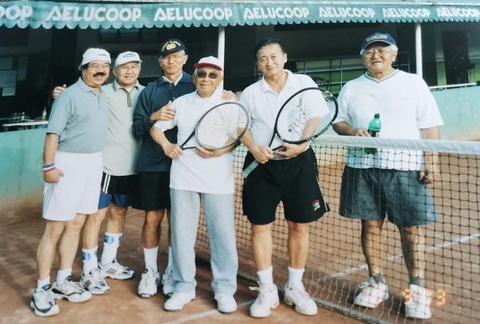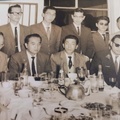
How many times do we return to our beginnings. Perhaps in our lifetime there will be many times that we will have to return. And today, as proof of love, I tired my hands with my tennis racket on the AELU courts. A little pichanguita like so many years ago, when the joy of playing was a pastime with the friends who little by little were leaving us. Life. The one that already appears in the old calendar of what we live and that, little by little and without much noise, tires our soul in each day that luckily we have to live.
Already being in our eighties, the body feels that there is a special permission for every amazement that our eyes show us every morning we wake up. We usually return from the fatigue of confinement and the bed in its dynamics shows us that our legs have the ritual of hope and that memory, in its hidden desire, scares us away from the oblivion that comes with the years that we have to live today. .
Going back will never be the exact repetition of our old calendars. Not even the sudden glimpse of the faithful friend we meet on a daily basis. Returning is simply our present, the fleeting term of our amazement at what was the ritual of a life that has passed and gone. Today I ignite the nostalgia of those who are no longer present. Of those who, without looking at the days or months, enjoyed how many hours of collective fatigue on the reddish fields of sport. What times those will not return! And remember two great tennis players of my time: Tito Ychikawa and Julio Yamashiro.
And of which we have a vast memory hidden among the flow of our memories. And there we stare at the sweat of some Tennis afternoons on the threshold that fixes us, an old and wrinkled almanac that formulates among its numbers the thirty years that have passed. A deluge of hours that are no longer repeated in the heart of our lives, alone and with the permission of a few thoughts, we turn the eternal light of memory into that beginning that knew how to guide us through a perfect life that will never return.
It is then that we take the idea of showing what we have already experienced and feeling in time gone the cold images that will soon become memories. Those years where running was the next step to take in our path. And the friend with the laziness of work only managed to move his head, hide his shoulder, walk smiling and feel the intense light of the night at his destination. Even so, fishing for us was a daily theme whenever the sea invited. And there, among the feats of the immense beaches, the reminder of a fishing that was intended to vibrate with the stormy attachment of spinning on the waves, that crown that the feeling of a fisherman wears between the whirlwind of his joy and passion. to see the prey pulled.
Today the vast majority have left and, without a doubt, the parched fishing lines tend to feel the distant cry of oblivion. There will no longer be the sinker at its beginning, nor the hooks predicting the tremor of a launch. The board – as we called it – will be a rotten piece of wood in the basket and the spinner will have the passion of its name enclosed in a crude can, forgotten by the years. Only the sea in the company of nostalgia stirs the verb of waves that draw in the sand the feeling, the passion, the hope and that sonorous and faithful laughter of which we flaunted for a well-told joke or a question that reached the bottom. of silence. And of those who were faithful to fishing I still have their names in the context of nostalgia and memory: Armando Uema, Máximo 'Cholo' Hirano, Jaimito Vattuone, Luis Matsumura, Víctor Guerra, Pedrito Luna.
They were other times, other years, other places, not reaching the age of twenty meant pedaling the bicycle for life, imitating the journeys of Teófilo Toda (the most famous Nisei cyclist in pedal sport) and arriving in Huancayo with a beating heart and full of passion. There, on Lomo Largo, the climb was zigzagging and the painful desire to have a soda was. The rain often locked us between a wet track or a farm that pretended to be planted with eucalyptus trees, the route so well known to us was a kind of solace memory. When taking Real Street and turning into Giráldez, then go up to La Libertad Hill and appreciate the beautiful city of Huancayo from there.
How can we not remember the Uchida family cafeteria, where three beautiful ladies were present. Guillermina, Marcela and Esther and, next to Víctor Nakasone and Hiro Kanashiro, we left the bicycles to have a coffee. Or maybe on Giráldez Street, in a fashion workshop with three nice ladies: Adela, Gloria Yamaguchi and Felicita Hojo, they showered us Nisei Jaujinos with attention. So many memories of those years in the 1950s, of forming the Nisei Jauja Club with the help of Víctor Aritomi, and leaving an important mark such as the Jauja Fire Company. And the carnival parties of the years 1959 and 1960, both in Jauja and Huancayo, where the Nisei youth of those years lived constantly between dances and friendships. That should return to the memories of many elderly people and especially the Nisei of Huancayo and Jauja, many of whom are no longer with us.

The illusion of the ball was the passion of my childhood. With her I gravitated towards the feeling of canceling my studies and the game of searching for her, kicking her, grabbing her and, above all, bagging her. I stopped spending my student years on the ball. The streets were painful without her and, in her sad domain, disfigure the round that was covered with Aunt Maximina Miyada's stockings. Then came the rubber one, in a dull red color. They were not big, but for our will they were the end of a goal in the arches made of stones and adobes. There, in La Samaritana and where its rough descent gave us a basin of water, with an endless stream that quenched our thirst and left us anxious about playing again the next day during school hours.
At the age of 18, the Nisei Jauja Club, which had just been formed, had the pride of becoming champion in the Second Division of Soccer and the following year, playing in the First Division, we finished last in the table. The championships were sudden and fleeting, as was the institutional life of the Nisei Jauja Club. Today they tell me that perhaps there is no one left from the Japanese Colony of that time and that my friend José Kato left us forever three years ago. He had a bazaar in the Main Park that belonged to his father. And to think that in the years I arrived in Jauja (1948), twenty-five families and twelve Nisei young people lived in the city.
Return. It is what I do from time to time, visit the city of Jauja either with my family or with my friends. Time has given us so many surprises, like when seven years ago, with Samuel Matsuda, Víctor Ykeda and Juancito Kanashiro we met in the Main Park with José Kato and visited Julio Tayra's house. My friend Julio was already feeling bad and today perhaps arriving at the Jauja Cemetery, friends and many acquaintances will be part of my usual visit and routine, of going to the Campo Santo where everyone rests in peace. Life is just the extension of all the memories that pass through our minds. And return as many times as the body and solitude invite us. It was the happiness we enjoyed, the years we lived.
© 2022 Luis Iguchi Iguchi






